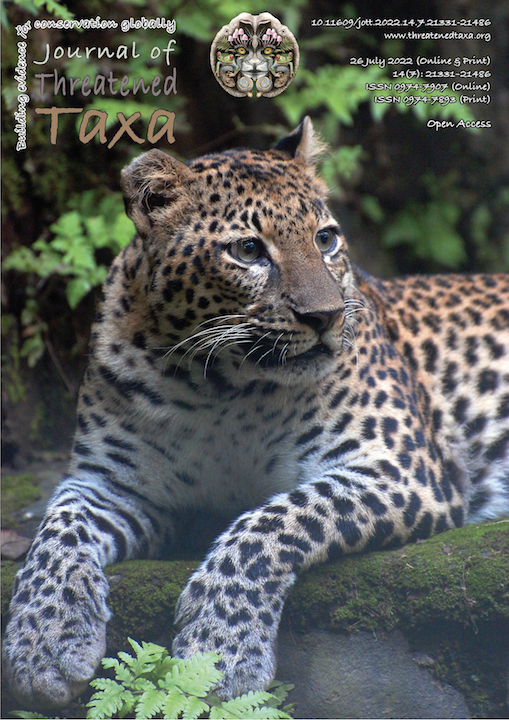Effects of a Bengal Slow Loris Nycticebus bengalensis (Primates: Lorisidae) bite: a case study from Murlen National Park, Mizoram, India
Main Article Content
Abstract
Lorisids are the only known venomous primates. Threatened by habitat loss and pet trade, lorises and the effects of their bite, have received little attention to date. Given the growing number of accounts of bites by lorises on humans and paucity of information on their venom, here we present a case study on the context and results of a Bengal Slow Loris bite that occurred in the vicinity of Murlen National Park, Mizoram, India.
Article Details

This work is licensed under a Creative Commons Attribution 4.0 International License.
Authors own the copyright to the articles published in JoTT. This is indicated explicitly in each publication. The authors grant permission to the publisher Wildlife Information Liaison Development (WILD) Society to publish the article in the Journal of Threatened Taxa. The authors recognize WILD as the original publisher, and to sell hard copies of the Journal and article to any buyer. JoTT is registered under the Creative Commons Attribution 4.0 International License (CC BY), which allows authors to retain copyright ownership. Under this license the authors allow anyone to download, cite, use the data, modify, reprint, copy and distribute provided the authors and source of publication are credited through appropriate citations (e.g., Son et al. (2016). Bats (Mammalia: Chiroptera) of the southeastern Truong Son Mountains, Quang Ngai Province, Vietnam. Journal of Threatened Taxa 8(7): 8953–8969. https://doi.org/10.11609/jott.2785.8.7.8953-8969). Users of the data do not require specific permission from the authors or the publisher.
References
Choudhury, A.U. (1992). The Slow Loris (Nycticebus coucang) in Northeast India. Primate Report 34: 77–83.
Choudhury, A.U. (2001). Primates in northeast India: An overview of their distribution and conservation. ENVIS Bulletin: Wildlife and Protected Areas 1(1): 92–101.
Das, N., J. Biswas, K. Bhattacharya & K.A.I. Nekaris (2016). Observations on the Bengal Slow Loris Nycticebus bengalensis in Pakke Tiger Reserve, Arunachal Pradesh, India. Asian Primates Journal 6(1): 27–32.
Gardiner, M., A. Weldon, S.A. Poindexter, N. Gibson & K.A.I. Nekaris (2018). Survey of practitioners handling slow lorises (Primates: Nycticebus): An assessment of the harmful effects of Slow Loris bites. Journal of Venom Research 9: 1–7.
Inoue, F., I. Akihiko, T. Takafumi, T. Ichikawa, M. Suga, S. Ishihara & S. Nakayama (2021). Severe anaphylactic shock following a Slow Loris bite in a patient with cat allergy. Internal Medicine 60: 3037–3039.
Jugli, S., J. Chakravorty & V.B. Meyer-Rochow (2020). Tangsa and Wancho of North-east India use animals not only as food and medicine but also as additional cultural attributes. Foods 9: 1–29. https://doi.org/10.3390/foods9040528
Kumar, A. (2009). Endangered slow loris’s journey from NERIST to Itanagar Biological Park. The Arunachal Times 1–2.
Kumar, A., K. Sharma, J. Panvor, K. Mazumdar, A. Devi, M. Krishna & P.C. Ray (2014). Threats to the Bengal Slow Loris Nycticebus bengalensis in and around Itanagar Wildlife Sanctuary, Arunachal Pradesh, India: Impediments to conservation. Endangered Species Research 23: 99–106. https://doi.org/10.3354/esr00540
Lyngdoh, A.W., P. Khatonier, J. Das & S. Lyngdoh (2021). A Survival blueprint for the conservation and management of the Bengal Slow Loris, Nycticebus bengalensis, in Meghalaya, India. An output from the EDGE of Existence fellowship, Zoological Society of London and National Geographic PhotoArk Program, 2019–2021.
Madani, G. & K.A.I. Nekaris (2014). Anaphylactic shock following the bite of a wild Kayan Slow Loris (Nycticebus kayan): Implications for Slow Loris conservation. Journal of Venomous Animals and Toxins including Tropical Diseases 20: 43. http://www.jvat.org/content/20/1/43
Nekaris, K.A.I. & V. Nijman (2007). CITES proposal highlights rarity of Asian nocturnal primates (Lorisidae: Nycticebus). Folia Primatologica 78: 211–214.
Nekaris, K.A.I., R.S. Moore, E.J. Rode & B.G. Fry (2013). Mad, bad and dangerous to know: The biochemistry, ecology and evolution of Slow Loris venom. Journal of Venomous Animals and Toxins Including Tropical Diseases 19: 21. http://doi.org/10.1186/1678-9199-19-21
Nekaris, K.A.I., H. Al-Razi, M. Blair, N. Das, Q. Ni, E. Samun, U. Streicher, J. Xue-long & L. Yongcheng (2020). Nycticebus bengalensis (errata version published in 2020). The IUCN Red List of Threatened Species 2020: e.T39758A179045340. https://doi.org/10.2305/IUCN.UK.2020-2.RLTS.T39758A179045340.en
Nijman, V. & K.A.I. Nekaris (2014). Traditions, taboos and trade in slow lorises in Sundanese communities in Southern Java, Indonesia. Endangered Species Research 25(1): 79–88. https://doi.org/10.3354/esr00610
Perkin, A. (2019). Rondo Dwarf Galago Paragalago rondoensis (Honess in Kingdon, 1997), pp. 24–27. In: Schwitzer, C., R.A. Mittermeier, A.B. Rylands, F. Chiozza, E.A. Williamson, D. Byler, S. Wich, T. Humle, C. Johnson, H. Mynott & G. McCabe (eds.). Primates in Peril: The World’s 25 Most Endangered Primates 2018–2020. IUCN SSC Primate Specialist Group, International Primatological Society, Global Wildlife Conservation, and Bristol Zoological Society, Washington, DC.
Radhakrishna, S., A.B. Goswami & A. Sinha (2006). Distribution and conservation of Nycticebus bengalensis in North-eastern India. International Journal of Primatology 27: 971–982.
Rode-Margono, J.E. & K.A.I. Nekaris (2015). Cabinet of Curiosities: Venom systems and their ecological function in mammals, with a focus on primates. Toxins 7: 2639–2658.
Roos, C., R. Boonratana, J. Supriatna, J.R. Fellowes, C.P. Groves, S.D. Nash, A.B. Rylands & R.A. Mittermeier (2014). An updated taxonomy and conservation status review of Asian primates. Asian Primates Journal 4(1): 2–38.
Rowe, N. (1996). A Pictorial Guide to the Living Primates. Pogonias Press, New York, NY.
Wilde, H. (1972). Anaphylactic shock following bite by a slow loris, Nycticebus coucang. American Journal of Tropical Medicine and Hygiene 21: 592−594.

